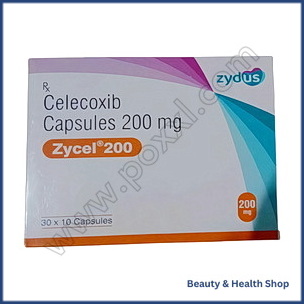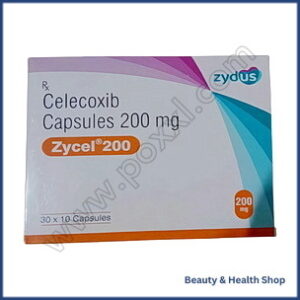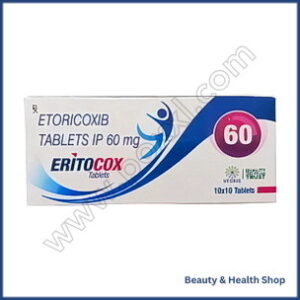ADDICTION
ALCOHOL DEPENDENCE
QUIT SMOKING
ALLERGY
ANTI FUNGAL
FUNGAL INFECTION
FUNGAL NAIL INFECTIONS
ANTI-REJECTION DRUGS
ANTI WORM
ANTIBIOTIC
BACTERIAL INFECTIONS
ARTHRITIS
GOUT
OSTEOARTHRITIS
RHEUMATOID ARTHRITIS
BLOOD
LOW PLATELET COUNT
THROMBOPHLEBITIS
VARICOSE VEINS
COLON
ANAL FISSURE
PILES
ULCERATIVE COLITIS
DIABETES CARE
DIABETES INSIPIDUS
DIABETES TYPE
DIABETIC FOOT ULCERS
GLUCOSE MONITOR
EYES/EAR CARE
DRY EYES
EYE CARE
EYE EXAMINATION
EYE INFECTION
EYE LASHES
EYE PAIN
GLAUCOMA
OCULAR HYPERTENSION
UVEITIS
FEVER CARE
MALARIA
RHEUMATIC FEVER
TYPHOID FEVER
GASTROINTESTINAL
ACIDITY
CONSTIPATION
CROHN'S DISEASE
DIARRHOEA
GALLBLADDER STONES
INTESTINAL ULCERS
IRRITABLE BOWEL SYNDROME
MOTION SICKNESS
NAUSEA
Zycel (Celecoxib)
Zycel 100 mg (Celecoxib)
| Amount | Price | Price / Unit |
Qty | ||
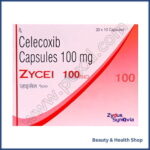
|
30 Capsules | $49.00 | $1.63 |
||

|
60 Capsules | $61.00 | $1.02 |
||

|
90 Capsules | $74.00 | $0.82 |
Zycel 200 mg (Celecoxib)
| Amount | Price | Price / Unit |
Qty | ||
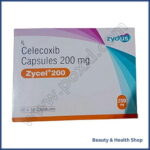
|
30 Capsules | $74.00 | $2.47 |
||

|
60 Capsules | $86.00 | $1.43 |
||

|
90 Capsules | $114.00 | $1.27 |
| Active Ingredient (Generic Name): | Celecoxib |
|---|---|
| Indication: | Pain Relief |
| Manufacturer | Zydus Cadila Pharma |
| Packaging: | 10 capsules in one strip |
From: $74.00
You are likely considering Zycel (celecoxib) to relieve pain and inflammation, common issues for many individuals who depend on nonsteroidal anti-inflammatory drugs (NSAIDs) like Zycel. Zycel is a prescription medication commonly used to treat osteoarthritis, rheumatoid arthritis, menstrual cramps, and certain cancers. It works by inhibiting enzymes that stimulate prostaglandin release, reducing COX-1 and COX-2, as well as lipoxygenase and phospholipase A2. Zycel is available in 50-400 mg capsules or tablets and is usually prescribed at 100-200 mg once or twice daily. When considering Zycel as a treatment option, it is important to be aware of its benefits, risks, and potential interactions.
Main Points
Zycel (Celecoxib) is an NSAID prescribed to alleviate pain and inflammation associated with osteoarthritis, rheumatoid arthritis, and similar conditions. It functions by inhibiting enzymes that prompt prostaglandin release, thereby reducing COX-1 and COX-2 levels, along with lipoxygenase and phospholipase A2. The typical dosage ranges from 100-200 mg once or twice daily, to be taken with a full glass of water, with or without food, under the supervision of a healthcare professional. Potential side effects and risks include stomach discomfort, skin reactions, and the possibility of drug interactions. Severe reactions may include serious breathing issues and facial swelling. It is important to note that Zycel may interact with blood thinners, antidepressants, and diuretics, and should be avoided during pregnancy, breastfeeding, and when using other NSAIDs such as aspirin or ibuprofen.
What Is Zycel (Celecoxib)?
Zycel, the brand name for celecoxib, is a nonsteroidal anti-inflammatory drug (NSAID) that reduces hormones causing pain and inflammation in the body. It is commonly used to treat conditions like osteoarthritis, rheumatoid arthritis, and acute pain. Zycel can also help manage symptoms of menstrual cramps, menstrual irregularities, and certain types of cancer. Available in capsule or tablet form, it is typically taken orally in various strengths from 50 mg to 400 mg once or twice daily. Adhering to the dosage instructions provided by your healthcare provider or on the prescription label is crucial for symptom relief and improved quality of life. It is important to address any concerns or questions with your healthcare provider to ensure safe and effective treatment.
How Zycel Works in Body
When Zycel is ingested, it hinders the activity of specific enzymes responsible for initiating the release of prostaglandins, hormone-like compounds that induce pain and inflammation in the body. By blocking these enzymes, Zycel diminishes the production of prostaglandins, leading to a reduction in pain and inflammation.
Zycel’s mode of action is as follows:
- Cyclooxygenase-1 (COX-1): Decreases the generation of prostaglandins linked to stomach ulcers and bleeding.
- Cyclooxygenase-2 (COX-2): Lowers the production of prostaglandins associated with pain and inflammation.
- Lipoxygenase: Reduces the formation of leukotrienes responsible for allergic reactions.
- Phospholipase A2: Diminishes the production of arachidonic acid, a precursor to prostaglandins.
Uses and Indications
In clinical practice, Zycel is commonly prescribed to manage Rheumatoid Arthritis by reducing inflammation and alleviating symptoms. It is also indicated for the treatment of Osteoarthritis, aiming to diminish pain and improve daily functioning. Understanding these therapeutic uses will enhance awareness of Zycel’s role in chronic pain management.
Rheumatoid Arthritis Treatment
Celecoxib, marketed as Zycel, is a common prescription for rheumatoid arthritis, an autoimmune condition causing joint inflammation and pain. Rheumatoid arthritis symptoms include swollen joints, stiffness, and fatigue. Zycel works by blocking prostaglandin production, reducing inflammation and pain. Improvement typically occurs within weeks of starting Zycel. Consistent intake is crucial, even if symptoms improve, to maintain its benefits. Your doctor may combine Zycel with other medications like DMARDs or corticosteroids for better results. Adhere to your doctor’s instructions, attend regular check-ups, and monitor for side effects. Proper use of Zycel can effectively manage rheumatoid arthritis symptoms and enhance your quality of life.
Osteoarthritis Relief
Zycel may be prescribed for osteoarthritis relief, a common degenerative joint disease characterized by cartilage deterioration and bone spurs. This condition affects a large number of individuals globally, leading to joint pain, stiffness, and limited mobility in areas like the hands, hips, knees, and spine. By inhibiting prostaglandin production, Zycel helps reduce inflammation and ease the pain associated with osteoarthritis.
When using Zycel, expect relief from symptoms such as joint pain, tenderness, and swelling. The medication functions by blocking the COX-2 enzyme, which is responsible for prostaglandin synthesis. By targeting this specific enzyme, Zycel minimizes the likelihood of stomach ulcers and bleeding commonly linked to non-selective NSAIDs.
Clinical trials have shown Zycel to be highly effective in alleviating osteoarthritis symptoms. It is crucial to adhere to your doctor’s instructions and take the medication as prescribed to achieve optimal outcomes. Remember to promptly report any side effects or concerns to your healthcare provider for safe and efficient treatment.
Dosage and Administration
Your doctor will typically prescribe 100-200 mg of Zycel (celecoxib) once or twice daily, depending on your condition. The dose may be adjusted based on your response and symptoms. Take Zycel as directed by your doctor, with a full glass of water, with or without food. Taking it with food can help reduce stomach upset. If you’re taking antacids, sucralfate, or cholestyramine, take Zycel at least 2 hours before or 6 hours after these medications to avoid reduced absorption.
Stick to your prescribed dosing schedule and do not stop taking Zycel without consulting your doctor, even if you feel better. Regular monitoring by your doctor is necessary to assess the effectiveness and safety of Zycel therapy, as it may be used for short or long-term treatment depending on your condition.
Common Side Effects
When taking Zycel (Celecoxib), watch out for common side effects like stomach upset, skin reactions, and potential interactions with other medications. Stomach upset should be monitored closely to prevent complications. Skin reactions and drug interactions are also possible outcomes to be cautious of during your treatment.
Stomach Upset Risks
What stomach upset risks are associated with taking Zycel (Celecoxib), and how can you minimize them? When taking Zycel, you may experience stomach upset in the form of nausea, vomiting, or stomach pain. These symptoms can be uncomfortable and disruptive.
To lower the risk of stomach upset, consider the following measures:
- Consume Zycel with food or milk to lessen irritation to the stomach lining.
- Avoid combining Zycel with antacids or other medications that may cause stomach irritation.
- Begin with a low dosage and gradually increase it as necessary, following your doctor’s guidance.
Skin Reaction Possibilities
Celecoxib use can lead to various skin reactions, such as rash, itching, and redness, with varying degrees of severity. Skin reactions may range from mild, like a slight rash or itching, to more serious conditions like Stevens-Johnson syndrome or toxic epidermal necrolysis. Monitoring your skin health while on celecoxib is crucial, and any unusual changes should be reported to your doctor promptly.
Individuals with a history of allergies or skin conditions are at higher risk of experiencing skin reactions. If you observe unusual skin changes such as blisters, peeling skin, or a rapidly spreading rash, seek immediate medical attention. Your doctor may adjust your dosage or recommend alternative treatments to reduce the likelihood of skin reactions.
In rare instances, celecoxib may trigger severe skin reactions like erythema multiforme or exfoliative dermatitis. Symptoms of these conditions, such as fever, sore throat, or facial swelling, require immediate medical attention. Your doctor will closely monitor your skin health and make necessary adjustments to your treatment plan to minimize the risk of skin reactions.
Interaction Warnings
When taking Zycel (celecoxib), it’s important to be aware of potential interactions with other medications. Combining Zycel with certain drugs, such as anticoagulants like warfarin, diuretics like furosemide, or ACE inhibitors like enalapril, can increase the risk of adverse effects. These interactions may lead to complications like bleeding, kidney damage, or high blood pressure.
To minimize the risk of interactions, make sure to disclose all medications, including over-the-counter drugs and supplements, to your healthcare provider. They may need to adjust your treatment plan or monitor you closely for any signs of side effects. Promptly report any unusual symptoms or reactions to ensure your safety while taking Zycel.
Rare but Serious Side Effects
While taking Zycel, you may encounter rare but severe side effects, such as allergic reactions, stomach ulcers, and bleeding. These reactions can be life-threatening and require immediate medical attention. Seek help promptly if you experience symptoms like breathing difficulties, facial or throat swelling, or skin rash. Stomach ulcers and bleeding may manifest as intense abdominal pain, vomiting blood, or black tarry stools. Discontinue Zycel if you notice any of these symptoms and consult your physician.
It’s important to note that Zycel could potentially elevate the risk of cardiovascular events, like heart attacks or strokes, especially in individuals with existing heart conditions. Liver damage is also a possibility, indicated by yellowing of the skin and eyes, dark urine, or abdominal discomfort. In rare instances, Zycel may induce anemia, leading to fatigue, pale skin, or breathing difficulties. It’s crucial to monitor your health closely while on Zycel and promptly report any unusual symptoms to your healthcare provider.
Drug Interactions and Warnings
When taking Zycel, it is crucial to be mindful of potential interactions with other medications like blood thinners, antidepressants, and diuretics, which can heighten the risk of bleeding, stomach ulcers, and other adverse effects. Inform your healthcare provider about all current medications to prevent possible interactions.
Certain medications that might interact with Zycel include:
- Warfarin and other anticoagulants: increasing the risk of bleeding
- Lithium: increasing the risk of lithium toxicity
- Fluconazole: heightening the risk of stomach ulcers and bleeding
Monitoring blood pressure and kidney function is essential while using Zycel, as it can elevate blood pressure and deteriorate kidney function in some cases. Avoid combining Zycel with other NSAIDs like aspirin or ibuprofen to reduce the likelihood of stomach ulcers and bleeding. By understanding these potential interactions and warnings, you can decrease the risk of adverse effects and support safe and effective treatment with Zycel.
Precautions and Contraindications
When considering the use of Zycel (Celecoxib), it is essential to be mindful of the precautions and contraindications associated with this medication. There is a risk of allergic reactions, so it is important to take steps to minimize this possibility. Additionally, it is advisable to be aware of the specific considerations for pregnancy and breastfeeding as they may impact your treatment plan.
Allergic Reaction Risks
Celecoxib, a nonsteroidal anti-inflammatory drug, may lead to allergic reactions, ranging from mild skin rashes to severe cases of anaphylaxis, a potentially life-threatening condition. Prior to starting Zycel, it is crucial to understand the possibility of an allergic response. Individuals with a history of allergic reactions to sulfa drugs, aspirin, or other NSAIDs are at a higher risk of reacting to celecoxib.
Those with a background of asthma should exercise caution, as it could elevate the likelihood of an allergic reaction. Recognize the following signs of an allergic response:
- Facial, lip, tongue, or throat swelling
- Breathing or swallowing difficulties
- Hives or itchy skin
If any of these symptoms occur, seek immediate medical attention. Your healthcare provider will evaluate the benefits of celecoxib in comparison to potential risks and recommend the most appropriate treatment plan.
Pregnancy and Breastfeeding
Avoid taking Zycel during pregnancy, especially in the third trimester, as it may harm the fetus and prolong labor. Zycel, a nonsteroidal anti-inflammatory drug (NSAID), can impact fetal development and increase bleeding risks. In the third trimester, Zycel can lead to premature closure of the ductus arteriosus, a crucial fetal blood vessel, potentially causing complications like pulmonary hypertension in newborns.
Discuss alternative treatments with your healthcare provider if you are planning a pregnancy or are already pregnant to assess the risks versus benefits of using Zycel. It is not recommended to take Zycel while breastfeeding due to unknown effects on infants. Consult your doctor for safer treatment options to ensure your baby’s well-being.
Overdose Symptoms and Treatment
Excessive consumption of Zycel (celecoxib) can lead to various symptoms that require immediate medical attention to prevent complications. If you suspect an overdose, seek medical help promptly. Symptoms may vary based on the dosage but commonly include:
- Nausea, vomiting, stomach pain, and bleeding
- Dizziness, headache, confusion
- Rapid heartbeat, low blood pressure, chest pain
Seek medical assistance if experiencing any of these symptoms. Treatment may involve inducing vomiting, administering activated charcoal, or gastric lavage to remove the excess drug. In severe cases, hospitalization for monitoring and supportive care may be necessary. Prompt medical attention is vital to prevent long-term harm or potential fatality from a Zycel (celecoxib) overdose.
Storage and Disposal
Proper storage and disposal of Zycel (celecoxib) are essential to prevent accidental ingestion, overdose, or environmental harm. Keep the medication out of reach of children and pets, stored in its original packaging in a cool, dry place. Avoid exposure to direct sunlight, moisture, or extreme temperatures.
When no longer needed or expired, dispose of Zycel correctly. Do not flush it down the toilet or pour it down the drain to prevent environmental contamination. Consult your pharmacist or local authorities for take-back programs or community disposal options. Consider participating in the U.S. Drug Enforcement Administration’s National Prescription Drug Take-Back Day for safe disposal of unused medications.
Always adhere to the disposal instructions provided by healthcare professionals to minimize risks and protect the environment.
Alternative Medications
If Zycel is not suitable for you, your healthcare provider may suggest alternative medications to help manage your symptoms. This could be due to factors like allergic reactions, drug interactions, or lack of effectiveness in treating your condition.
Some alternative medications that offer similar benefits to Zycel include:
- Meloxicam: a nonsteroidal anti-inflammatory drug (NSAID) commonly used for osteoarthritis and rheumatoid arthritis.
- Naproxen: another NSAID often prescribed for pain, inflammation, and stiffness in conditions like arthritis.
- Ibuprofen: a widely used NSAID for pain relief, inflammation reduction, and treating various conditions
Looking to buy Zycel 200 mg (Celecoxib) for effective pain relief? Our online pharmacy offers convenient ordering and fast delivery. .
Discuss your medical history and concerns with your healthcare provider to determine the best alternative medication for your needs.
Frequently Asked Questions
Can I Take Zycel With Other Pain Relievers Like Acetaminophen or Ibuprofen?
When considering taking pain relievers together, it is important to exercise caution. You can take acetaminophen or ibuprofen with Zycel, but be aware of the potential risks. Combining these medications can increase the risk of stomach ulcers and bleeding. It is advisable to consult your healthcare provider or pharmacist before taking multiple pain relievers simultaneously. They can help you assess the benefits and risks and develop a safe treatment plan tailored to your individual needs.
Is Zycel Safe to Use During Pregnancy or Breastfeeding?
When considering pregnancy or breastfeeding, caution is advised when using any medication. It is generally recommended to avoid taking nonsteroidal anti-inflammatory drugs (NSAIDs) like Zycel during these periods. The FDA categorizes NSAIDs as category C, indicating potential risks to the fetus or baby. It is important to consult with your doctor for personalized guidance on using Zycel safely during pregnancy or breastfeeding.
Can I Drive or Operate Heavy Machinery While Taking Zycel?
When taking Zycel, it’s important to be cautious when driving or operating heavy machinery. Side effects like dizziness, drowsiness, and blurred vision can affect your ability to do these tasks safely. It’s crucial to assess how your body reacts to the medication before engaging in such activities. If you experience any negative effects, it’s advisable to refrain from driving or using heavy machinery until the symptoms improve.
How Long Does It Take to See the Effects of Zycel?
The onset of action of Zycel can vary from person to person and depends on the condition being treated. Typically, you may start to notice pain relief and reduced inflammation within a week of taking Zycel. However, it may take up to two weeks to experience the full therapeutic effects. It is important to adhere to your doctor’s instructions and recommended dosage for optimal results.
Is Zycel Habit-Forming or Addictive?
Zycel, a non-steroidal anti-inflammatory drug (NSAID), is not known to be habit-forming or addictive. It does not impact the brain’s reward system, reducing the likelihood of physical dependence or withdrawal symptoms upon discontinuation. Adherence to your doctor’s prescribed dosage is crucial for safe and effective use, minimizing the risk of adverse effects.
Conclusion
Ensure you are well-informed about Zycel (celecoxib), an NSAID used to alleviate pain and inflammation by inhibiting COX-2 and reducing prostaglandins. This medication is administered in capsule form, with dosages ranging from 100 mg to 400 mg. Common side effects may include stomach upset, headache, and dizziness. Adhere strictly to your doctor’s instructions and promptly report any severe adverse reactions.


